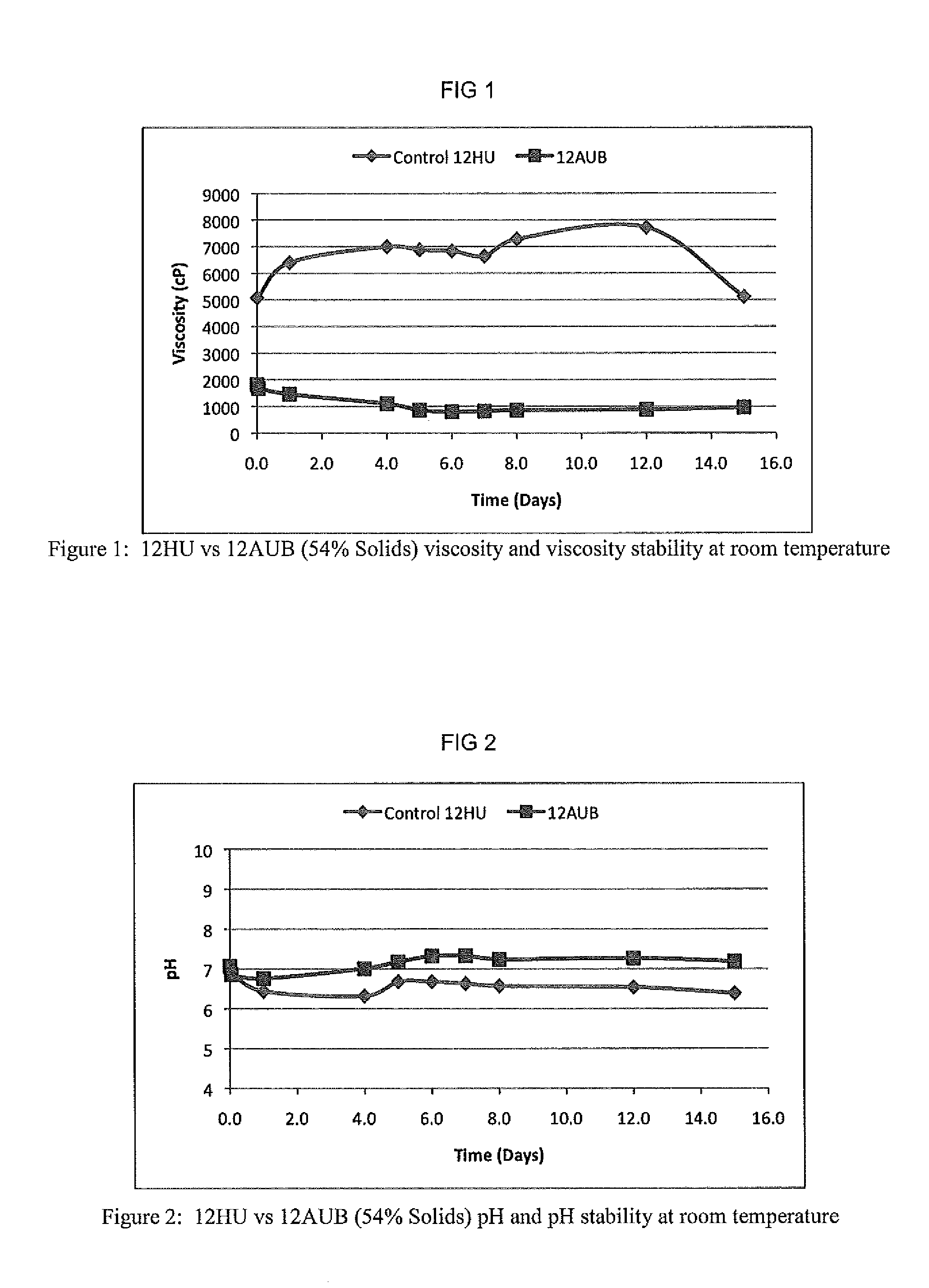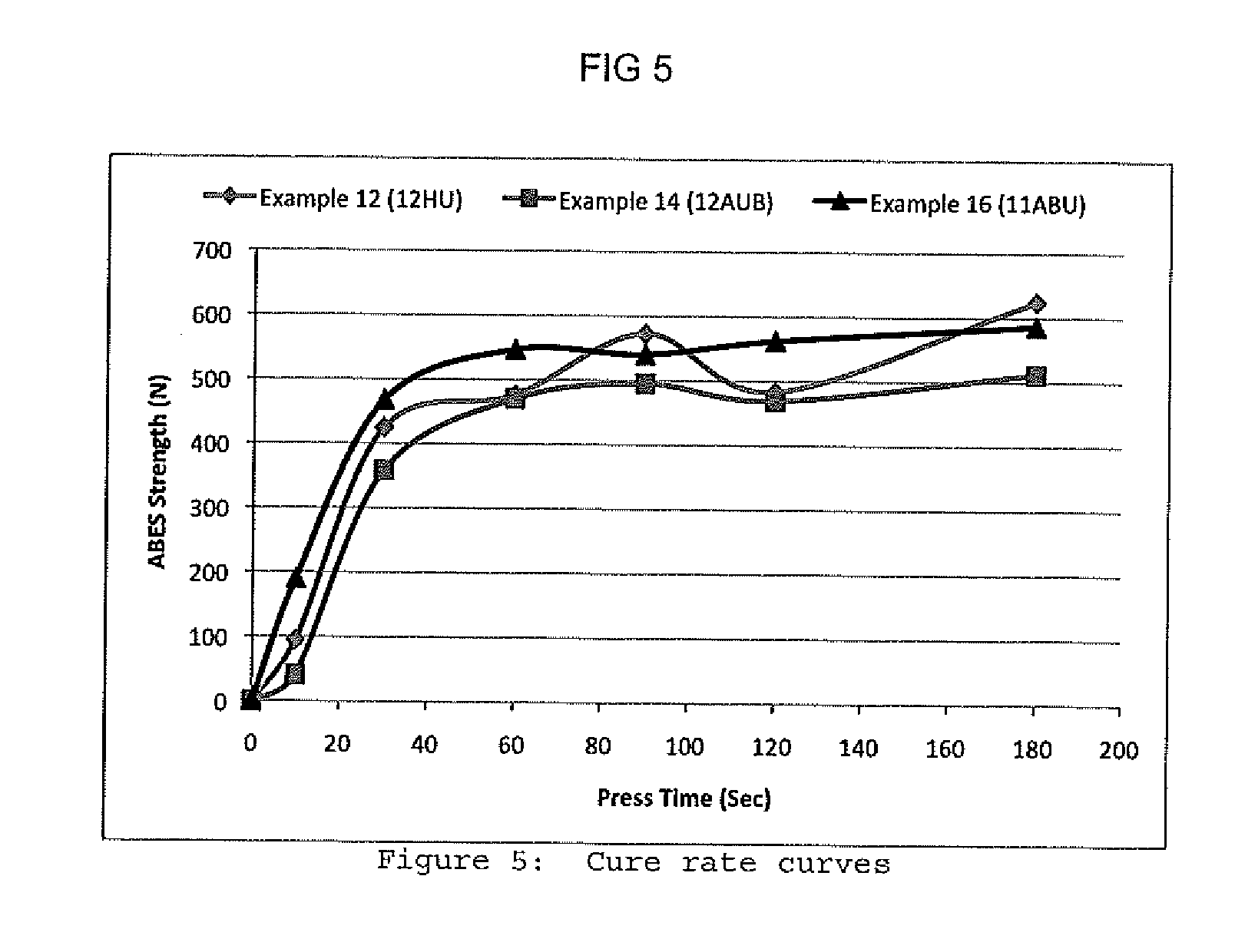Stable Acid Denatured Soy/Urea Adhesives and Methods of Making Same
a technology of acid denatured soy/urea and adhesive, which is applied in the preparation of glue/gelatin, wood working apparatus, protein coatings, etc., can solve the problems of reducing performance, limiting the use of soybean adhesives in interior applications, and common in the prior art soybean adhesives exhibit limited pot life, etc., and achieves excellent stability, high solids, and compatibility.
- Summary
- Abstract
- Description
- Claims
- Application Information
AI Technical Summary
Benefits of technology
Problems solved by technology
Method used
Image
Examples
example 3
Acid Denatured Adhesive—Soy / Urea=1:2 @ 54% Total Solids (12AU-54)
[0077]Soy flour was acid-denatured and then combined with urea to produce a stable soy / urea aqueous product. The formula used for this experiment is provided in Table 2.
[0078]Preparation Procedure: Water was charged into a three-neck round bottom flask equipped with an overhead mechanical stirrer. The sodium bisulfite was added to the room temperature water followed by the addition of the soy flour over a period of five minutes. The mixture was stirred for 30 minutes at room temperature (Viscosity=2800 cP w / RV#5, pH=6.03). The acid (50% sulfuric acid) was then added drop-wise to the rapidly stirring mixture until a pH of 3.0 (referred to as the acid denatured pH) was reached and, subsequently, held for an additional 30 minutes. The urea was then quickly added to the rapidly stirring acid denatured soy mixture and allowed to stir for 5 minutes. The addition of the urea cooled the soy adhesive; so the adhesive was warmed...
example 4
Acid Denatured Adhesive—Soy / Urea=1:2 @ 54% Total Solids (12AUB-54)
[0079]To the resin produced in example 3, base (50% NaOH) was added slowly to the rapidly stirring adhesive to raise the pH to 7.
TABLE 3Formula for Example 4SequenceIngredientAmount (g)Solids(g)% to Soy01Example 3630340.202NaOH (50%)18.29.12.7Totals648.2349.3% Solids53.9
Final Properties: pH=7.07, Viscosity=1820 cP (spindle #4)
example 5
Acid Denatured Adhesive—Soy / Urea=1:2 @ 60% Total Solids (12AUB-60)
[0081]The acid denaturing process affords products that are significantly lower in viscosity than previously used heat denaturing. This allows for even higher final solids products to be produced. In this example, a 60% solids adhesive is prepared in a manner similar to that described in Examples 2 and 3. A similar sample at 60% solids of the heat treated adhesive was so viscous that it could not be stirred. In this example, Advantage 357 was added to reduce the foaming tendency often observed when mixing soy flour. The acid denatured pH for this example was 3.5.
TABLE 6Formula for Example 5SequenceIngredientAmount (g)Solids(g)% to Soy01Water486.802Sodium bisulfite2.52.51.0003Adv. 3570.750.7504Soy Flour-90263.2250.005H2SO4 (50%)28.714.35.706Urea500.0500.020007NaOH (50%)23.211.64.6Totals1305.2779.2% Solids59.7
Final Properties: pH=7.04, Viscosity=2340 cP (spindle #4)
PUM
| Property | Measurement | Unit |
|---|---|---|
| temperatures | aaaaa | aaaaa |
| temperature | aaaaa | aaaaa |
| temperature | aaaaa | aaaaa |
Abstract
Description
Claims
Application Information
 Login to View More
Login to View More - R&D
- Intellectual Property
- Life Sciences
- Materials
- Tech Scout
- Unparalleled Data Quality
- Higher Quality Content
- 60% Fewer Hallucinations
Browse by: Latest US Patents, China's latest patents, Technical Efficacy Thesaurus, Application Domain, Technology Topic, Popular Technical Reports.
© 2025 PatSnap. All rights reserved.Legal|Privacy policy|Modern Slavery Act Transparency Statement|Sitemap|About US| Contact US: help@patsnap.com



